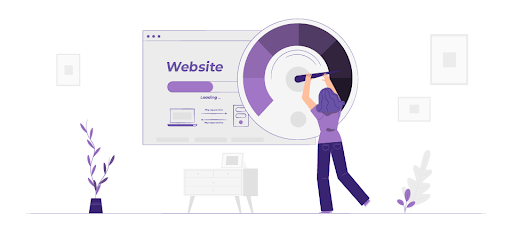What Is Time to First Byte and Why It Matters
-
Abdul Wadood

Have you ever wondered why some websites seem to load instantly while others take forever? In today’s world of instant gratification and short attention spans, a fast website is essential. The speed at which your site loads can make or break your business. One of the most important metrics for measuring website performance is time to first byte or TTFB.
There are several ways to improve your TTFB and make your website faster. Optimizing images, caching static content, choosing a fast web host, and cleaning up your code are all effective techniques for speeding up your site and providing a better experience for your visitors. Paying attention to TTFB and website speed may seem tedious, but it can have a huge impact on your traffic, conversions, and revenue.
Table of Contents:
What Exactly Is Time to First Byte?
Time to first byte (TTFB) refers to the amount of time it takes for a web page to start loading after a user requests it. In other words, it’s the time between when you click a link or enter a URL and when the first byte of information starts downloading.
TTFB matters because it directly impacts a user’s experience on your site. If it takes more than a couple seconds, visitors may get impatient and bounce. Studies show that decreasing page load times, especially TTFB, can significantly improve metrics like bounce rate, time on page, and conversions.
There are a few factors that determine a page’s TTFB:
- Server location. The closer your server is to the user, the faster the response time. Using a content delivery network (CDN) can help minimize latency.
- Server specs. More powerful servers with solid-state drives (SSDs), lots of memory, and fast processors will yield better TTFB. Cloud hosting also tends to outperform shared hosting.
- Code optimization. Well-optimized code, minimized files, compressed images, caching, etc. allow pages to load faster. Cleaning up your code and getting rid of bloat will improve TTFB.
- The number of requests. The more requests a page makes to load content like images, scripts, and stylesheets, the longer TTFB will be. Reducing HTTP requests is one of the best ways to speed up your site.
TTFB is an important metric to monitor to ensure you’re providing the best experience for your visitors. By optimizing your servers, code, and number of requests, you can achieve a TTFB of under 1-2 seconds and create a fast, engaging user experience. Focusing on speed and performance is worth the effort. Your users and your bottom line will thank you.
Why Time to First Byte Matters for Website Performance
Time to first byte (TTFB) refers to how long it takes for a web page to start loading after a user clicks a link or enters a URL. Why does it matter? Because in today’s fast-paced world, every millisecond counts.
As an impatient internet user, you expect pages to load instantly. If a site takes more than 2-3 seconds to start loading, there’s a good chance you’ll get frustrated and click away. For businesses, this means lost customers and revenue. Studies show that a one-second delay in page load time can result in a 7% drop in conversions.
To improve your TTFB, there are a few things you can do:
- Optimize your images. Large images are one of the biggest contributors to slow load times. Compress and resize your images to the smallest size possible.
- Minify your code. Remove unnecessary spaces, line breaks, and indentation in your HTML, CSS, and JavaScript files. This can shave precious milliseconds off your TTFB.
- Enable caching. Caching allows you to store copies of files, images, and web pages so they can load faster on repeat visits. By enabling caching, you can cut your TTFB in half.
- Choose a fast web host. The server your site is hosted on has a huge impact on TTFB. Make sure to choose a web host that offers a fast network, SSD storage, and optimizes servers for performance.
- Avoid redirects. Redirects are when a web page sends visitors to a different URL. Each redirect adds to your TTFB, so minimize them when possible.
By focusing on these few simple tips, you can drop your TTFB down to under 1 second and provide visitors with the fast, seamless experience they expect. After all, in a world where every millisecond matters, shaving just a few hundred milliseconds off your time to the first byte can make a big difference.
How to Measure Your Website's Time to First Byte

To optimize your website’s performance, you need to measure its time to the first byte or TTFB. This is the time it takes for a visitor’s browser to receive the first byte of information from your web server. The faster the TTFB, the faster your website will load and the better the user experience.
There are a few ways to test your TTFB:
- Use a website speed test tool. Popular options include GTmetrix, Pingdom, and PageSpeed Insights. These tools will analyze your website and provide you with metrics like your TTFB. Most aim for under 200 milliseconds (ms) for a good TTFB.
- Check your web server logs. Your web host should provide access to logs that show details for each visitor like IP address, timestamp, and TTFB. Look for average times over 200ms which could indicate performance issues.
- Use a website monitoring service. Services like Uptime Robot, StatusCake, and Freshping can ping your website at set intervals and provide reports on your TTFB and other metrics. They can alert you if your TTFB spikes so you can take action.
- Test from multiple locations. Run speed tests and check your TTFB from different geographic regions and internet connections. Differences of 100ms or more could mean your content delivery network or web host needs optimization.
- Check for overloaded resources. Things like unoptimized images, excessive JavaScript, and too many plugins or widgets can overload your web server and increase TTFB. Minify code, compress images and remove unnecessary add-ons.
Improving your TTFB may require tweaking your web server configuration, caching static content, or upgrading to a faster web hosting plan. But measuring your TTFB is the first step to speeding up your website and keeping your visitors happy.
Acceptable Time to First Byte Values and Benchmarks
As an IT professional monitoring your web servers and applications, time to first byte (TTFB) is an important metric to track. TTFB measures the time from when a user makes a request to your server until the first byte of the response is received. In other words, it’s how long it takes for your server to start sending a response after a request comes in.
Acceptable TTFB Values
For most websites, an acceptable TTFB is anywhere from 100 to 200 milliseconds. Anything under 200ms will feel instant to users and is a good target. As TTFB climbs higher, to 300ms or more, website performance will start to feel sluggish and can negatively impact user experience.
If your TTFB values are consistently over 200ms, it’s time to investigate and optimize. Some things to check include:
- Server load and performance. If your servers are overloaded or underpowered, they won’t be able to respond quickly to requests.
- Application efficiency. Poorly optimized web applications, database queries, and code can increase TTFB. Look for ways to streamline and speed up your application.
- Caching. Enabling caching at multiple levels (application, database, object, etc.) can dramatically speed up TTFB by reducing the work the server has to do for each request.
- CDN. Using a content delivery network (CDN) to serve static assets like images, CSS, and JS files can lighten the load on your servers and improve TTFB.
Benchmarking your TTFB over time is also helpful to identify trends and the impact of optimizations. Many monitoring tools can track your TTFB and alert you if it goes above a certain threshold. Keeping a close eye on TTFB and making improvements to stay within an acceptable range will ensure fast, responsive performance for your users.
How to Improve Your Website's Time to First Byte

Improving your website’s time to first byte (TTFB) should be a top priority. TTFB refers to how long it takes for a visitor’s browser to receive the first byte of information from your web server. The faster your TTFB, the better the user experience.
Optimize your code
Go through your website code line by line to remove any unnecessary elements that could slow down load time. Look for unused JavaScript, CSS, images, and widgets. Minify any CSS and JS files to remove whitespace and comments. This streamlines your code so browsers can load it faster.
Use a CDN
A content delivery network (CDN) distributes your website content across multiple servers around the world. This means visitors access your site from the server closest to them, reducing latency. Using a CDN can significantly improve your TTFB.
Compress your images
Large image files take longer to load and increase your TTFB. Use an image compressor tool to shrink the file size of images without sacrificing quality. For photos, aim for a file size of 100 to 200 KB. You should see major speed improvements, especially for visitors on mobile networks.
Pro tip: If you have a WordPress website, you can use the All in One SEO plugin to add breadcrumbs. If you have manually created your website, you may have to code or hire a developer to help you add breadcrumbs.
Enable caching
Caching stores website components like images, CSS, and JavaScript files in the visitor’s browser so they load instantly on subsequent page views. This lowers your TTFB and provides a better user experience. Enable caching through your web host or a caching plugin.
For effective internal linking:
- Use descriptive anchor text
- Ensure relevance between linked pages
- Avoid adding too many internal links on a page
Choose a fast web host
A slow, overloaded web host will directly impact your TTFB. Look for a host that offers SSD storage, ample CPU resources, and an optimized server stack. Cloud hosting and managed WordPress hosts are good options. They provide a powerful infrastructure to support fast page load times.
Migrating to a new web host is an easy way to gain significant speed improvements if your current host is lacking. With some optimizations, you can turn a slow, clunky website into a fast, streamlined experience for your visitors. Focusing on your TTFB is worth the effort.
Conclusion
So now you know what time to first byte is and why it’s important to pay attention to it. Faster sites and apps keep visitors engaged and coming back. They make the overall experience more pleasant and help you get more done in less time. As technology and internet speeds advance, expectations around website and app performance rise too. Keeping your time to the first byte low is key to staying ahead of the competition and keeping your users happy. If you want people to stick around and engage with your digital product, focus on optimization and speed. Give your visitors an experience that feels instant and they’ll reward you with their loyalty.
